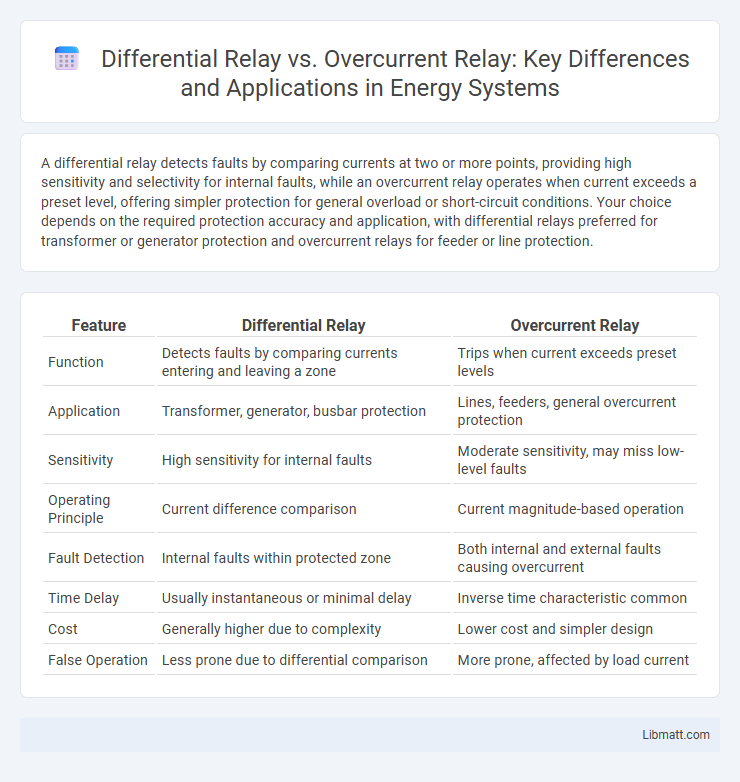A differential relay detects faults by comparing currents at two or more points, providing high sensitivity and selectivity for internal faults, while an overcurrent relay operates when current exceeds a preset level, offering simpler protection for general overload or short-circuit conditions. Your choice depends on the required protection accuracy and application, with differential relays preferred for transformer or generator protection and overcurrent relays for feeder or line protection.
Table of Comparison
| Feature | Differential Relay | Overcurrent Relay |
|---|---|---|
| Function | Detects faults by comparing currents entering and leaving a zone | Trips when current exceeds preset levels |
| Application | Transformer, generator, busbar protection | Lines, feeders, general overcurrent protection |
| Sensitivity | High sensitivity for internal faults | Moderate sensitivity, may miss low-level faults |
| Operating Principle | Current difference comparison | Current magnitude-based operation |
| Fault Detection | Internal faults within protected zone | Both internal and external faults causing overcurrent |
| Time Delay | Usually instantaneous or minimal delay | Inverse time characteristic common |
| Cost | Generally higher due to complexity | Lower cost and simpler design |
| False Operation | Less prone due to differential comparison | More prone, affected by load current |
Introduction to Protective Relays
Protective relays are essential devices in electrical power systems designed to detect faults and initiate circuit breaker operations to prevent equipment damage. Differential relays offer high sensitivity by comparing current differences between two or more points, making them ideal for detecting internal faults in transformers, generators, and busbars. Overcurrent relays operate based on the magnitude of current exceeding a preset threshold and are widely used for general fault protection in transmission lines and distribution feeders.
What is a Differential Relay?
A differential relay is a protection device that detects faults by comparing the current entering and leaving a protected zone, typically used in transformers, generators, and busbars to identify internal faults. It operates based on the principle that the currents at both ends of the protected equipment should be equal under normal conditions, and any significant difference indicates a fault. This relay provides fast and selective protection by isolating only the faulty section, minimizing damage and improving system reliability.
What is an Overcurrent Relay?
An overcurrent relay is a protective device designed to detect excessive current flow in electrical circuits, indicating faults such as short circuits or overloads. It operates by sensing current levels above a preset threshold and initiates circuit breaker tripping to prevent equipment damage and maintain system stability. Unlike differential relays, which compare currents at different points, overcurrent relays respond solely to the magnitude of current passing through their location.
Working Principle: Differential Relay vs Overcurrent Relay
Differential relays operate by comparing the current entering and leaving a protected zone, tripping the circuit breaker when a difference indicative of a fault occurs, ensuring rapid and precise fault detection. Overcurrent relays function by detecting current levels exceeding preset thresholds, relying on time-inverse characteristics to trip during sustained fault conditions. Your choice depends on the protection requirements, with differential relays offering more selective fault detection and overcurrent relays providing simpler overcurrent protection.
Key Applications in Power Systems
Differential relays are primarily used for protecting transformers, generators, and motors by detecting phase angle differences caused by faults within the protected zone, ensuring high sensitivity and selectivity for internal faults. Overcurrent relays are widely applied for general protection of distribution lines and feeders, operating when current exceeds preset thresholds due to faults or overloads, offering simplicity and cost-effectiveness. Your power system reliability benefits by using differential relays for critical equipment and overcurrent relays for broader line protection.
Sensitivity and Selectivity Comparison
Differential relays offer superior sensitivity by detecting minute differences in current between two or more points, enabling precise fault identification within protected zones. Overcurrent relays provide broader protection by responding to current exceeding preset thresholds but may lack selectivity in complex network conditions, potentially causing unnecessary tripping. The high selectivity of differential relays reduces false trips during external faults, ensuring targeted protection, whereas overcurrent relays may respond to faults outside their intended protection area.
Advantages of Differential Relays
Differential relays offer superior sensitivity and selective fault detection by comparing current inputs from multiple points to detect discrepancies, minimizing false trips during external faults. They provide faster and more precise protection in electrical systems, particularly in transformers, generators, and busbars, enhancing overall system reliability. Your protection scheme benefits from differential relays' ability to distinguish between internal faults and inrush currents, reducing unnecessary outages and maintenance costs.
Advantages of Overcurrent Relays
Overcurrent relays provide simple and cost-effective protection by detecting current exceeding a predetermined threshold, ideal for protecting distribution lines and general equipment. They offer faster fault clearance in high-fault current conditions and require less complex wiring compared to differential relays. Your electrical system benefits from their ease of installation, maintenance, and reliable performance in a wide range of overload and short-circuit scenarios.
Limitations and Challenges
Differential relays offer precise fault detection by comparing current differences between circuit sections but face limitations such as sensitivity to CT saturation, requiring accurate matching and coordination. Overcurrent relays, while simpler and more cost-effective, struggle with selectivity and may cause nuisance trips during inrush currents or temporary overloads. Both relay types require careful setting coordination and regular maintenance to ensure reliability and minimize false tripping in complex power systems.
How to Choose Between Differential and Overcurrent Relays
Choosing between differential and overcurrent relays depends on the specific application and protection requirements of electrical equipment. Differential relays provide precise fault detection by comparing current differences between two points, ideal for transformers and generators, while overcurrent relays are better suited for simpler, cost-effective protection by measuring current magnitude exceeding preset thresholds. Evaluating factors such as fault sensitivity, selectivity, system complexity, and budget constraints guides the optimal relay selection for reliable power system protection.
Differential relay vs Overcurrent relay Infographic

 libmatt.com
libmatt.com